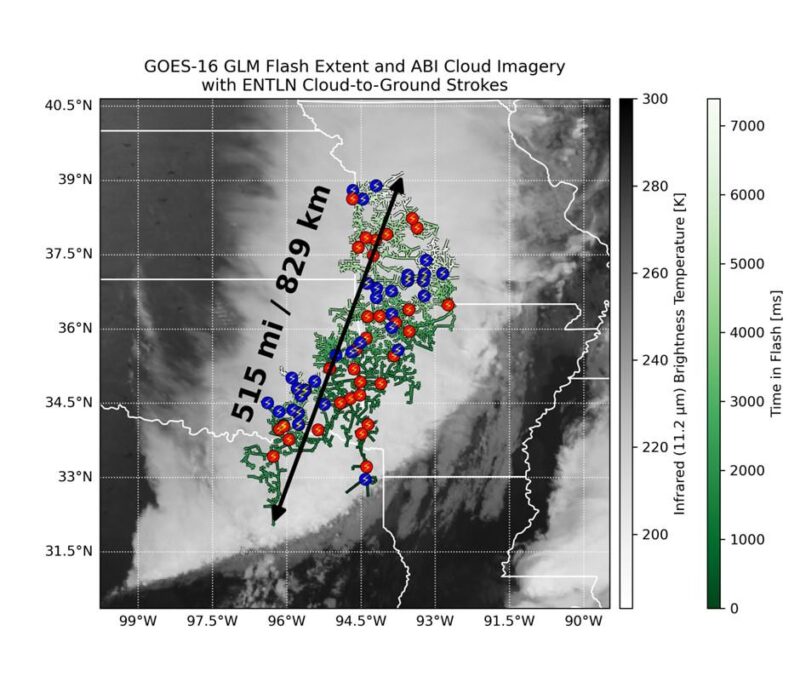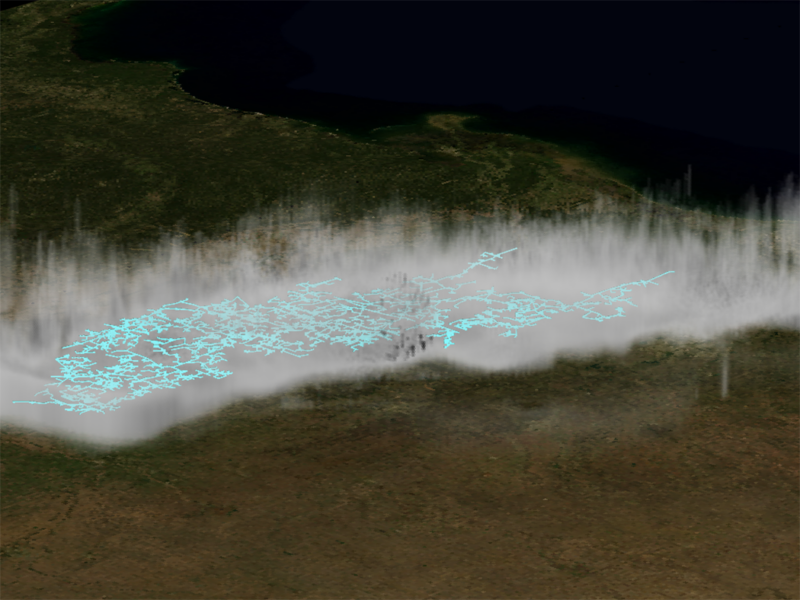On July 31, 2025, the World Meteorological Organization certified a new lightning record. It’s for the world’s longest lightning flash, an incredible 829 km (515 miles) in a notorious storm hotspot in the United States. The flash happened in 2017. Watch in the player above or on YouTube.
- There’s a new record for the world’s longest-recorded single lightning flash. It stretched 515 miles (829 km).
- The GOES-16 satellite monitored the megaflash, which stretched from East Texas to Kansas City.
- See other lightning extreme records below. The WMO Weather and Climate Extremes Archive maintains the official records.
Megaflash lightning record set in the United States
On July 31, 2025, the World Meteorological Organization (WMO) confirmed a new world record for the longest lightning flash. It was an incredible 515 miles (829 km) in a notorious storm hotspot in the United States.
The megaflash happened in October 2017, during a major thunderstorm complex. It extended from eastern Texas to near Kansas City. That’s the equivalent to the distance between Paris and Venice in Europe. It would take a car about 8 to 9 hours and a commercial plane at least 90 minutes to cover that distance.
WMO’s Committee on Weather and Climate Extremes, which maintains official records of global, hemispheric and regional extremes, recognized the new record with the help of the latest satellite technologies. The peer-reviewed Bulletin of the American Meteorological Society published the findings on July 31, 2025.
WMO Secretary-General Celeste Saulo said:
Lightning is a source of wonder, but also a major hazard that claims many lives around the world every year and is therefore one of the priorities for the international Early Warnings for All initiative.
These new findings highlight important public safety concerns about electrified clouds, which can produce flashes that travel extremely large distances and have a major impact on the aviation sector and can spark wildfires.
A lightning bolt hundreds of miles long
There is a margin of error of plus or minus 5 miles (8 km) in the new record of 515 miles (829 km). It is 40 miles (61 km) greater than the previous record. And that record covered a distance of 477.2 ± 5 miles (768 ± 8 km) across parts of the southern United States on April 29, 2020.
The new record lightning flash occurred in one of the hotspots for Mesoscale Convective System (MCS) thunderstorms. The dynamics of these storms in the Great Plains in North America permit extraordinary megaflashes to occur.
Both the previous and new record used the same maximum great-circle distance methodology to measure flash extent. The 2017 event is notable in that it was one of the first storms where NOAA’s newest Geostationary Operational Environmental Satellite (GOES-16) documented lightning megaflashes. These megaflashes are notable as extremely long duration/distance lightning discharge events.
This particular flash was not identified in the original 2017 analysis of the storm but was discovered through a re-examination of the thunderstorm.

Weather records
Professor Randall Cerveny, rapporteur of Weather and Climate Extremes for WMO, said:
This new record clearly demonstrates the incredible power of the natural environment. Additionally, WMO assessment of environmental extremes such as this lightning distance record testify to the significant scientific progress in observing, documenting and evaluating such events. It is likely that even greater extremes still exist, and that we will be able to observe them as additional high-quality lightning measurements accumulate over time.
The WMO Archive of Weather and Climate Extremes maintains official records of the world, hemispheric and regional extreme records associated with a number of specific types of weather. Presently, the Archive lists extremes for temperature, pressure, rainfall, hail, wind and lightning as well as two specific types of storms, tornadoes and tropical cyclones.
Other previously accepted WMO lightning extremes are:
- The greatest duration for a single lightning flash of 17.102 ± 0.002 seconds during a thunderstorm over Uruguay and northern Argentina on June 18, 2020.
- Direct strike: 21 people killed by a single flash of lightning as they huddled for safety in a hut in Zimbabwe in 1975.
- Indirect strike: 469 people killed in Dronka, Egypt, when lightning struck a set of oil tanks, causing burning oil to flood the town in 1994.
From lightning record to science insight
Lightning specialist and committee member Walt Lyons said:
Investigation of megaflashes is providing new insights into the mesoscale electrical charge variations in Mesoscale Convective System thunderstorms. Furthermore, it illustrates the threat of the newly recognized ‘bolt from the gray,’ analogous to the ‘bolt from the blue’ from isolated cells, but one that can travel many hundreds of kilometers from the main charge generating region.
The only lightning-safe locations are substantial buildings that have wiring and plumbing; not structures such as at a beach or bus stop. The second reliably safe location is inside a fully enclosed metal-topped vehicle; not dune buggies or motorcycles.
If lightning is within 10 km [6 mi] as found with reliable lightning data, go to the lightning safe building or vehicle. As these extreme cases show, lightning can arrive within seconds over a long distance, but they are embedded within larger thunderstorms, so be aware.

Space-based technology
The previous assessments that established the flash duration and extent records used data collected by ground-based Lightning Mapping Array (LMA) networks. Many lightning scientists acknowledged there are upper limits for the scale of lightning that any existing LMA could observe. Identifying megaflashes beyond these extremes would require a lightning mapping technology with a larger observation domain.
Recent advances in space-based lightning mapping offer the ability to measure flash extent and duration continuously over broad geospatial domains.
Lead author and evaluation committee member Michael J. Peterson of the Severe Storms Research Center (SSRC) at the Georgia Institute of Technology said:
The extremes of what lightning is capable of are difficult to study because it pushes the boundaries of what we can practically observe. Adding continuous measurements from geostationary orbit was a major advance. We are now at a point where most of the global megaflash hotspots are covered by a geostationary satellite. And data processing techniques have improved to properly represent flashes in the vast quantity of observational data at all scales.
Over time as the data record continues to expand, we will be able to observe even the rarest types of extreme lightning on Earth and investigate the broad impacts of lightning on society.
Bottom line: On July 31, 2025, the World Meteorological Organization certified a new lightning record. It’s for the longest lightning bolt, at 515 miles (829 km), which occurred in 2017.











